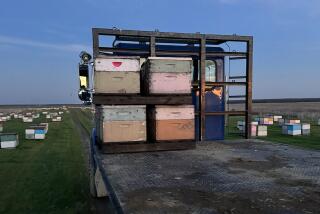A Bee Sting a Day Keeps Our Pain Away, Apitherapy Believers Insist
- Share via
YARMOUTH, Maine — Feeling bad? Take a sting.
Pluck a honeybee from a jar, hold it to your skin, and let it sink its stinger into your flesh.
First it stings like Hades. Then it itches. Then comes soothing relief from pain.
So say bee-lievers in apitherapy, or bee venom therapy.
Undaunted by warnings that the procedure is medically unproven and possibly dangerous, thousands of people who suffer from arthritis, multiple sclerosis and other problems are relying on apitherapy for relief.
Some physicians share their enthusiasm, but many say science doesn’t support the cure-all claims.
Stanford Brown, a beekeeper in Yarmouth, is a believer. He was tired of taking as many as 100 aspirin a week for his rheumatoid arthritis, so he put his bees to work.
“I’d get spasms so bad they’d twist me right up,” he said. “I couldn’t run or play with my kids. Many times, I’d be trying to get out of bed, and I’d have to slide out onto the floor, I’d be so stiff.”
Brown, now 77, began his bee venom therapy about 25 years ago. Since then, he has had bees sting him as often as three times a week, depending on the severity of his symptoms.
Proponents of the technique say it works by reducing inflammation and boosting the body’s immune system. Multiple sclerosis patients say it promotes nerve transmissions.
Bee venom also is believed to stimulate the production of cortisone, said Dr. Theodore Cherbuliez of Scarsdale, N.Y., a psychiatrist and president of the American Apitherapy Society.
Cherbuliez, who guides people interested in bee-sting therapy, said bees can be placed at the specific trouble spots or along the spine to distribute venom to various parts of the body.
He says he has seen improvements in people who suffer from arthritis, multiple sclerosis, depression, chronic fatigue, shingles, skin tumors, premenstrual syndrome and other problems.
According to the Ohio-based apitherapy society, more than 3,000 physicians in North America practice the technique. The group has collected information from more than 10,000 people worldwide who claim to benefit from the bee venom.
Cherbuliez makes no promises that the venom will be effective, however.
“Some people ask me, am I worried that I will get into trouble with the law?” he said. “I spend no time worrying about it. I’m not doing anything illegal. I’m not saying it is an approved method.”
But many physicians worry that patients may be recklessly embracing an unproven technique.
“People who are tempted to consider bee stings should be working with their physicians to explore other appropriate treatments,” said Dr. Doyt Conn, vice president of medical affairs at the Arthritis Foundation in Atlanta. “Not only is this bee-sting therapy unproven, but potentially dangerous.”
In addition to treating himself, Brown shares some of the more than 5 million bees he keeps in his backyard with other people.
With his bee-sting kit close by, he first does a “test sting”--to make sure the person isn’t allergic to bee stings--he said. He then sends the person home with a jar of bees, a piece of honeycomb and a bit of paper towel roll, because the bees like the darkness inside the tube.
Brown is not keeping track, but he estimates that he’s helped hundreds of people. One is a woman with multiple sclerosis.
Such stories trouble Patricia O’Looney, director of research and medical programs at the National Multiple Sclerosis Society, which is funding a study that involves injecting laboratory animals with purified bee venom.
“The difficulty with any of these reports is that they’re anecdotal,” she said. “The individuals or physicians who claim there’s a benefit haven’t followed up with the proper scientific studies.”
No two cases of MS are alike, O’Looney ssaid, and sometimes symptoms come and go for no apparent reason.
“With MS, the disease is so complex and varied that one cannot conclude that the fact that someone gets bee stings and then feels better necessarily means it’s because of the stings,” she added.
Back in Stanford Brown’s kitchen, half a dozen bees bopped against the sides of a small jar. Using long tweezers, he grasped one and held it against the top of his hand. When he discarded the bee, its stinger remained, standing upright and pulsating as the venom sack made its way into his flesh.
A patch of skin on Brown’s hand reddened and swelled, and itching set in.
The apitherapy society doesn’t treat patients or make referrals, but it does act as a clearinghouse for information about apitherapy.
“Someday, someone is going to research this in an organized way with replicated studies,” said entomologist Austin Haws, who is not a member of the society but tries to keep up on apitherapy information.
Twelve years ago, Haws was studying bees in the jungles of Ecuador--and suffering from a severe attack of hay fever--when a fellow researcher persuaded him to “take a sting.”
Today, the retired Utah State University biology professor continues to use bee venom to treat his hay fever and arthritis.
“I keep a gallon jar of bees and do it right here at home,” he said. “The stings hurt like Hades, but they only hurt for a few minutes, and after that, the arthritic pain is nearly gone.”
People have asked Haws, 76, to help them jump on the bee bandwagon, but he rarely agrees.
“I don’t push it on other people or recommend it,” he said. “I’m sort of my own guinea pig.”
In May, the Multiple Sclerosis Assn. of America announced plans to fund a bee-venom study. The Georgetown University study will begin by researching the properties of bee-venom extract, followed by national clinical trials if the first phase of research appears promising, spokesman Peter Damiri said.
“In the past few years, we’ve seen a huge trend in people trying to take the management of their symptoms into their own hands,” Damiri said. “We are not endorsing or recommend that anyone do this. We are simply saying it’s out there and needs to be investigated.”
But Helen Brown, Stanford’s wife, says she has all the proof she needs that bee venom works.
“I believe God led us to bees,” she said. “I have no doubt that Stan wouldn’t be standing here without them.”






